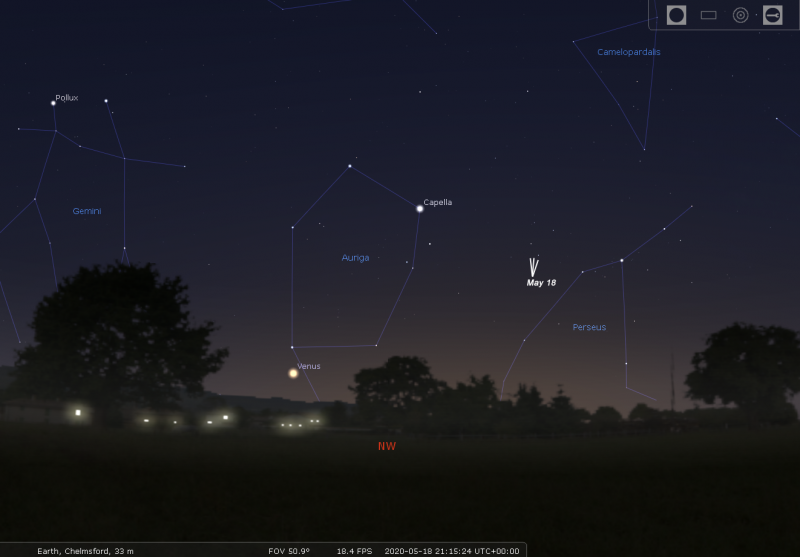2020 March 8
C/2019 Y4 (ATLAS) – A bright Spring Comet?
It is never a good idea to predict anything other than the orbital motion of a comet so please take the following with a rather large pinch of salt.
C/2019 Y4 (ATLAS) was discovered on 2019 December 28. It has a similar orbit to the Great Comet of 1844 (C/1844 Y1) and it may be a fragment of a common parent body. It has an orbital period of 5500 years and comes to perihelion at q=0.25 au on May 31. The comet has been brightening quite rapidly and it has probably had multiple passes through the inner Solar System so we might expect it to be quite active.
It was around 19th magnitude at discovery (r = 2.95au) and it is already 10th mag (r = 1.95au). At the current rate of brightening the comet could reach naked eye visibility in early April and be negative magnitude at perihelion (although this should come with a big, comet health warning) although the elongation will only be 12 deg at perihelion. The current COBS lightcurve is here. It will be interesting to see if the rapid brightening continues into April.
The comet is currenly a nicely placed evening object in Ursa Major. In late March it moves into Camelopardalis and the elongation rapidly decreases in May as it heads to perihelion. A chart is here 2019y4.pdf.
The latest images are in our archive: http://www.britastro.org/cometobs/2019y4/thumbnails.html.
If we are lucky we could have a nice comet in the evening twilight sky at the end of May. The position is shown below for May 18th. Let’s keep our fingers crossed that this one is the one!

https://britastro.org/wp-content/uploads/2022/02/2019y4_20200306_22360304_dgb.jpg
https://britastro.org/wp-content/uploads/2022/03/2019y4_20200306_22360304_dgb.jpg
https://britastro.org/wp-content/uploads/2022/03/2019y4_20200306_22360304_dgb.jpg
https://britastro.org/wp-content/uploads/2022/02/2019y4_20200306_22360304_dgb.jpg
https://britastro.org/wp-content/uploads/2022/02/2019y4_20200306_22360304_dgb.jpg
https://britastro.org/wp-content/uploads/2022/02/2019y4_20200306_22360304_dgb.jpg
https://britastro.org/wp-content/uploads/2022/02/2019y4_20200306_22360304_dgb.jpg
https://britastro.org/wp-content/uploads/2022/02/2019y4_20200306_22360304_dgb.jpg
https://britastro.org/wp-content/uploads/2022/02/2019y4_20200306_22360304_dgb.jpg
https://britastro.org/wp-content/uploads/2022/02/2019y4_20200306_22360304_dgb.jpg
https://britastro.org/wp-content/uploads/2022/02/2019y4_20200306_22360304_dgb.jpg
https://britastro.org/wp-content/uploads/2022/02/2019y4_20200306_22360304_dgb.jpg
https://britastro.org/wp-content/uploads/2022/02/2019y4_20200306_22360304_dgb.jpg
https://britastro.org/wp-content/uploads/2022/02/2019y4_20200306_22360304_dgb.jpg
https://britastro.org/wp-content/uploads/2022/02/2019y4_20200306_22360304_dgb.jpg
https://britastro.org/wp-content/uploads/2020/03/stellarium-013.png
https://britastro.org/wp-content/uploads/2022/02/2019y4_20200306_22360304_dgb.jpg
https://britastro.org/wp-content/uploads/2022/02/2019y4_20200306_22360304_dgb.jpg
https://britastro.org/wp-content/uploads/2022/02/2019y4_20200306_22360304_dgb.jpg
https://britastro.org/wp-content/uploads/2022/02/2019y4_20200306_22360304_dgb.jpg
https://britastro.org/wp-content/uploads/2022/02/2019y4_20200306_22360304_dgb.jpg
https://britastro.org/wp-content/uploads/2022/02/2019y4_20200306_22360304_dgb.jpg
https://britastro.org/wp-content/uploads/2022/02/2019y4_20200306_22360304_dgb.jpg
https://britastro.org/wp-content/uploads/2022/02/2019y4_20200306_22360304_dgb.jpg
https://britastro.org/wp-content/uploads/2022/02/2019y4_20200306_22360304_dgb.jpg
https://britastro.org/wp-content/uploads/2021/07/2019y4_20200306_22360304_dgb.jpg
https://britastro.org/wp-content/uploads/2021/07/2019y4_20200306_22360304_dgb.jpg
https://britastro.org/wp-content/uploads/2020/03/2019y4_20200306_22360304_dgb.jpg
| The British Astronomical Association supports amateur astronomers around the UK and the rest of the world. Find out more about the BAA or join us. |
